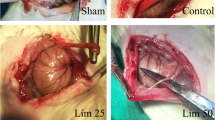Abstract
Purpose
A novel pharmacological mechanism of valproate was analyzed using a hamster model of adhesion.
Methods
Valproate or placebo was administered just after cecal injury and adhesion severity scores and histological were analyzed.
Results
The adhesion severity scores in the placebo- and valproate-treated groups were 2.67 ± 0.42 and 1.0 ± 0.37, respectively, with a significant difference between the groups. A significant increase in mast cell numbers was observed in the placebo-treated group vs. the sham-operated group; however, the mast cell number in the adhesive lesion was significantly lower in the valproate-treated group than in the placebo-treated group. The number of cells positive for chymase, an enzyme in mast cells, in the adhesive lesion was significantly higher in the placebo-treated group, but its increase was attenuated significantly by treatment with valproate. The myeloperoxidase gene expression level in the cecum was significantly higher in the placebo-treated group than in the sham-operated group, but there was no significant difference in the myeloperoxidase gene expression level between the sham-operated and valproate-treated groups in. In an in vitro experiment, valproate inhibited purified human and hamster chymases dose-dependently.
Conclusion
The chymase inhibitory effect of valproate may contribute to prevent adhesion formation after abdominal injury.








Similar content being viewed by others
References
Ellis H, Moran BJ, Thompson JN, Parker MC, Wilson MS, Menzies D, et al. Adhesion-related hospital readmissions after abdominal and pelvic surgery: a retrospective cohort study. Lancet. 1999;353:1476–80.
Schnüriger B, Barmparas G, Branco BC, Lustenberger T, Inaba K, Demetriades D. Prevention of postoperative peritoneal adhesions: a review of the literature. Am J Surg. 2011;201:111–21.
Otake K, Uchida K, Yoshiyama S, Inoue M, Okita Y, Watanabe H, et al. Effects of a hyaluronate-carboxymethylcellulose membrane (Seprafilm) on human polymorphonuclear neutrophil functions. J Surg Res. 2008;149:243–9.
Ozeki M, Jin D, Miyaoka Y, Masubuchi S, Hirokawa F, Hayashi M, et al. Comparison of a chymase inhibitor and hyaluronic acid/carboxymethylcellulose (Seprafilm) in a novel peritoneal adhesion model in rats. PLoS One. 2019;14:e0211391.
Liebman SM, Langer JC, Marshall JS, Collins SM. Role of mast cells in peritoneal adhesion formation. Am J Surg. 1993;165:127–30.
Yao YL, Ishihara T, Takai S, Miyazaki M, Mita S. Association between the expression of mast cell chymase and intraperitoneal adhesion formation in mice. J Surg Res. 2000;92:40–4.
Longley BJ, Tyrrell L, Ma Y, Williams DA, Halaban R, Langley K, et al. Chymase cleavage of stem cell factor yields a bioactive, soluble product. Proc Natl Acad Sci USA. 1997;94:9017–21.
Okamoto Y, Takai S, Yamada M, Miyazaki M. Chymase inhibitors may prevent postoperative adhesion formation. Fertil Steril. 2002;77:1044–8.
Soga Y, Takai S, Koyama T, Okamoto Y, Ikeda T, Nishimura K, et al. Attenuation of adhesion formation after cardiac surgery with a chymase inhibitor in a hamster model. J Thorac Cardiovasc Surg. 2004;127:72–8.
Soga Y, Takai S, Koyama T, Okamoto Y, Ikeda T, Nishimura K, et al. Attenuating effects of chymase inhibitor on pericardial adhesion following cardiac surgery. J Card Surg. 2007;22:343–7.
Suda S, Katsura K, Kanamaru T, Saito M, Katayama Y. Valproic acid attenuates ischemia-reperfusion injury in the rat brain through inhibition of oxidative stress and inflammation. Eur J Pharmacol. 2013;707:26–31.
Zhao T, Li Y, Liu B, Liu Z, Chong W, Duan X, et al. Novel pharmacologic treatment attenuates septic shock and improves long-term survival. Surgery. 2013;154:206–13.
Blanchard F, Chipoy C. Histone deacetylase inhibitors: new drugs for the treatment of inflammatory diseases? Drug Discov Today. 2005;10:197–204.
Assem ES, Peh KH, Wan BY, Middleton BJ, Dines J, Marson CM. Effects of a selection of histone deacetylase inhibitors on mast cell activation and airway and colonic smooth muscle contraction. Int Immunopharmacol. 2008;8:1793–801.
Adachi S, Maruyama T, Kondo T, Todoroki T, Fukao K. The prevention of postoperative intraperitoneal adhesions by tranilast: N-(3′,4′-dimethoxycinnamoyl) anthranilic acid. Surg Today. 1999;29:51–4.
Takai S, Shiota N, Yamamoto D, Okunishi H, Miyazaki M. Purification and characterization of angiotensin II-generating chymase from hamster cheek pouch. Life Sci. 1996;58:591–7.
Hulka JF, Omran K, Berger GS. Classification of adnexal adhesions: a proposal and evaluation of its prognostic value. Fertil Steril. 1978;30:661–5.
Miyaoka Y, Jin D, Tashiro K, Masubuchi S, Ozeki M, Hirokawa F, et al. A novel hamster nonalcoholic steatohepatitis model induced by a high-fat and high-cholesterol diet. Exp Anim. 2018;67:239–47.
Takai S, Sakaguchi M, Jin D, Baba K, Miyazaki M. Effects of daphnodorin A, daphnodorin B and daphnodorin C on human chymase-dependent angiotensin II formation. Life Sci. 1999;64:1889–966.
Zhang Z, Zhang ZY, Wu Y, Schluesener HJ. Valproic acid ameliorates inflammation in experimental autoimmune encephalomyelitis rats. Neuroscience. 2012;221:140–50.
Ishida K, Takai S, Murano M, Nishikawa T, Inoue T, Murano N, et al. Role of chymase-dependent matrix metalloproteinase-9 activation in mice with dextran sodium sulfate-induced colitis. J Pharmacol Exp Ther. 2008;324:422–6.
Kakimoto K, Takai S, Murano M, Ishida K, Yoda Y, Inoue T, et al. Significance of chymase-dependent matrix metalloproteinase-9 activation on indomethacin-induced small intestinal damages in rats. J Pharmacol Exp Ther. 2010;332:684–9.
Ten Broek RPG, Stommel MWJ, Strik C, van Laarhoven CJHM, Keus F, van Goor H. Benefits and harms of adhesion barriers for abdominal surgery: a systematic review and meta-analysis. Lancet. 2014;383:48–59.
Funding
This study was partially supported by Grants 61671098 and 31560312 from the National Nature Science Foundation of China and Grants 17K09741 and 18K06709 from the Japan Society for the Promotion of Science.
Author information
Authors and Affiliations
Contributions
SL: conception, investigation, and formal analysis; LL: conception, investigation, and formal analysis; DJ: investigation, formal analysis, and validation; QZ: project administration, supervision, writing—review, and editing; ST: project administration, supervision, writing—review, and editing. All authors contributed to the research.
Corresponding authors
Ethics declarations
Conflict of interest
We have no conflicts of interest to declare.
Additional information
Publisher's Note
Springer Nature remains neutral with regard to jurisdictional claims in published maps and institutional affiliations.
Rights and permissions
About this article
Cite this article
Liu, S., Liu, L., Jin, D. et al. The novel mechanism of valproate to prevent peritoneal adhesion formation. Surg Today 50, 1091–1098 (2020). https://doi.org/10.1007/s00595-020-01979-8
Received:
Accepted:
Published:
Issue Date:
DOI: https://doi.org/10.1007/s00595-020-01979-8




